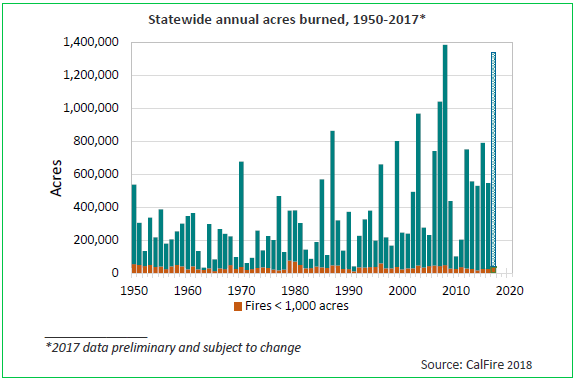December 7, 2019 - Wildfires are burning more acreage each year in California. Six of the largest fire years since 1950 have occurred after 2005. Fourteen of the 20 largest wildfires occurred between 2000 and 2017. In 2017, California wildfires killed more than 40 people, injured many more, destroyed thousands of structures, and caused billions of dollars in damages. (The state has since experienced its largest, deadliest and most destructive wildfires in 2018.)
Wildfires are a natural part of California’s landscape. Much of the state’s forests are adapted to periodic burning, but this pattern has been significantly altered by land use and fire management practices. Winter rains promote the growth of vegetation that later dries during summer and becomes fuel for wildfires.
An increase in the number of large wildfires throughout the western United States has been linked to warmer temperatures and earlier snowmelt. California’s recent unprecedented drought, intensified by unusually warm temperatures, increased the risk for extreme, high severity wildfires that spread rapidly. Climate change will continue to make drier and hotter conditions more likely, making vegetation easier to burn.
What does this indicator show?
The number of acres burned by wildfires statewide has been increasing since 1950. Although fewer in number, large fires – affecting 1,000 acres or more – account for most of the area burned each year. On average there are about half as many large fires each year than fires affecting less than 1,000 acres.
Why is this indicator important?
The loss of human lives and the devastation caused by recent wildfires in the state are a grim reminder of the fires’ destructive potential. The Tubbs fire that raged across Sonoma and Napa Counties in October 2017 led to 44 deaths, the evacuation and disruption of the lives of more than 100,000 residents, and over $9 billion in residential and commercial insurance claims. The November 2018 Camp Fire in Butte County is now the deadliest and most destructive fire in the state’s history, and the Mendocino Complex Fire in July 2018 – which burned about 460,000 acres in Colusa, Lake, Mendocino and Glenn Counties – the largest. The aftermath of a wildfire can be equally destructive. Heavy rains over areas left barren by the Thomas Fire in Ventura and Santa Barbara Counties triggered massive mudslides that killed more than a dozen people and caused further property loss and damage.
Emissions from wildfires can severely impact air quality locally and downwind. Health effects from exposure to particulate matter in wildfire smoke range from eye and respiratory tract irritation, to reduced lung function, exacerbation of asthma and heart failure, and premature death.
Forests play an important part in regulating levels of atmospheric carbon by removing and storing carbon dioxide, a greenhouse gas, from the atmosphere through natural processes. Wildfires release the stored carbon as carbon dioxide and black carbon, contributing to further warming. With the increasing size and intensity of wildfires, scientists are concerned that some forest lands are releasing carbon faster than they are able to store it.
Wildfires also threaten ecosystems. They damage watersheds and wildlife habitats, impacting the plant and animal populations they support. In a warming climate, wildfires are a growing threat, projected to increase in frequency and severity.
Fire suppression in California has become an increasingly high priority for federal, state, and local land management agencies. As large wildfires increase in size and number and the fire season grows longer, the cost of firefighting has been consuming a greater proportion of resource management budgets for federal and state lands that otherwise could be spent on sustainable forest programs.
For more information about this and other climate change indicators, visit:
https://oehha.ca.gov/climate-change/report/2018-report-indicators-climate-change-california
Downloads
![]() Wildfires - Feb 11, 2019
Wildfires - Feb 11, 2019
Source: OEHHA









